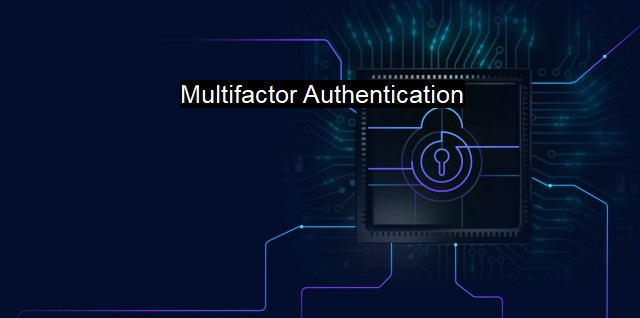What is Multifactor Authentication?
The Importance of Multifactor Authentication (MFA) in Cybersecurity: Enhancing Security with Layers of Protection
Multifactor authentication, often shortened to MFA, is a security method that requires the input of more than one form of identification before allowing access to digital systems or data. In today's era of growing technology and increasing threats from hackers, this method provides an additional layer of protection which can be indispensable in safeguarding sensitive information. An area of burgeoning importance in the broader landscape of cybersecurity, MFA enhances the existing systems and offers an extra deterrent against potential nefarious activities by creating obstacle after obstacle for hackers to get past.Centrally, MFA operates on the principle of combining inputs from two or more of the three accepted identification categories. These are usually summarized as “something you know,” “something you have,” or “something you are”.
"Something you know" is generally the traditional password or personal identification number (PIN). This practically ubiquitous method of identification can be compromised with relative ease especially if the password is weak, directed to a single point of attack, or revealed through hacking, social engineering, or simple surveillance.
"Something you have" involves items such as smartphones, smart cards, or token devices. These commonly held instruments add a level of physical challenge for the hackers to overcome, as stealing tangible items tends to involve more risk and can be easier to detect.
"something you are" often refers to biometric measures, including fingerprint identification, facial or retina recognition, voice identification, or even DNA signatures. These biological markers are unique and inherently personalized, and their sophistication makes them particularly resilient against replication attempts.
In an MFA regime, an authentic user, after generating a standard password, will be prompted to authenticate their identity through one or both of the other categories. For instance, those using their online banking application might input their customary password before being sent a text message containing a code which they must supply to access their account. Other times, fingerprint or facial recognition might be mandated to unlock an encrypted smartphone.
With the escalating stakes and its dangerous fallout being demonstrated through manifold incidents of stolen data, financial frauds, or breaches of privacy, the need for advanced protective methods such as MFA is non-negotiable. Critically, it promises to significantly reduce the opportunities for unauthorized exploitation of passwords, personal identifiers, and other sensitive identification materials.
The sophistication in the design and prompting of identification mechanisms is being augmented by other interlinked security measures such as antivirus software. Antivirus software looks at the data—web pages, files, software, applications—travelling over the network to your devices. It searches for known threats and monitors the behavior of all programs, flagging suspicious behavior. Its role in antivirus defense is pivotal.
It is important to understand that MFA and antivirus software do not necessarily replace one another; rather they display synergy when integrated for optimum security. Because while MFA acts as a guardian preventing unauthorized users from gaining access to the system, antivirus software focuses on eliminating threats that have already penetrated the system. It is like having both a front-line defense and a safety net.
Taken together, MFA and antivirus software create a fully layered security system that works both internally and externally offering an essential mix of defenses against the vitriolic wave of cybersecurity threats globally. Understanding and implementing MFA provides a practical commitment to ensuring safer, more secure navigation through today's digital world.

Multifactor Authentication FAQs
What is multifactor authentication (MFA)?
Multifactor authentication (MFA) is a security measure that requires users to provide two or more forms of authentication in order to access a system or application. This typically includes something the user knows, such as a password, as well as something the user has, such as a smartphone, smartcard, or token.Why is multifactor authentication important for cybersecurity?
Multifactor authentication is important for cybersecurity because it adds an extra layer of protection against unauthorized access to sensitive data or systems. Even if an attacker manages to obtain or guess a user's password, they will still need an additional form of authentication to gain access, making it much more difficult for them to compromise the system.What are some common types of multifactor authentication?
Some common types of multifactor authentication include SMS-based authentication, biometric authentication (such as fingerprint or facial recognition), smartcards, security tokens, and mobile apps. In some cases, multiple forms of authentication may be used in combination to provide even greater security.How can I implement multifactor authentication in my organization?
The process for implementing multifactor authentication will vary depending on the specific tools and systems being used. However, some general steps to consider include identifying which systems or applications require MFA, selecting the appropriate MFA tools or technologies, configuring and testing the MFA solution, and training users on how to use it effectively. It may also be helpful to work with a cybersecurity expert or consultant to ensure that your MFA implementation is comprehensive and effective.| | A | | | B | | | C | | | D | | | E | | | F | | | G | | | H | | | I | | | J | | | K | | | L | | | M | |
| | N | | | O | | | P | | | Q | | | R | | | S | | | T | | | U | | | V | | | W | | | X | | | Y | | | Z | |
| | 1 | | | 2 | | | 3 | | | 4 | | | 7 | | | 8 | | |||||||